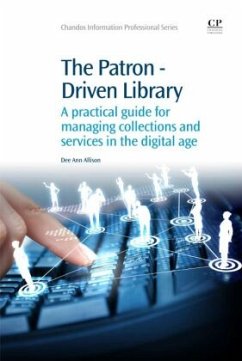Dee Ann Allison
The Patron-Driven Library
A Practical Guide for Managing Collections and Services in the Digital Age
Dee Ann Allison
The Patron-Driven Library
A Practical Guide for Managing Collections and Services in the Digital Age
- Broschiertes Buch
- Merkliste
- Auf die Merkliste
- Bewerten Bewerten
- Teilen
- Produkt teilen
- Produkterinnerung
- Produkterinnerung
"A guide for librarians to develop a new relationship with technology that preserves the core mission of libraries while responding to the needs of a new generation of library clients"--Page xxii.
Andere Kunden interessierten sich auch für
![Library Classification Trends in the 21st Century Library Classification Trends in the 21st Century]() Rajendra KumbharLibrary Classification Trends in the 21st Century47,99 €
Rajendra KumbharLibrary Classification Trends in the 21st Century47,99 €![Qualitative Research and the Modern Library Qualitative Research and the Modern Library]() Valeda Dent GoodmanQualitative Research and the Modern Library47,99 €
Valeda Dent GoodmanQualitative Research and the Modern Library47,99 €![The Role of the Electronic Resources Librarian The Role of the Electronic Resources Librarian]() George StachokasThe Role of the Electronic Resources Librarian53,99 €
George StachokasThe Role of the Electronic Resources Librarian53,99 €![Understanding the Internet Understanding the Internet]() Understanding the Internet53,99 €
Understanding the Internet53,99 €![Conversations with Leading Academic and Research Library Directors Conversations with Leading Academic and Research Library Directors]() Patrick LoConversations with Leading Academic and Research Library Directors66,99 €
Patrick LoConversations with Leading Academic and Research Library Directors66,99 €![Chinese Librarianship in the Digital Era Chinese Librarianship in the Digital Era]() Chinese Librarianship in the Digital Era46,99 €
Chinese Librarianship in the Digital Era46,99 €![The Theory and Practice of the Dewey Decimal Classification System The Theory and Practice of the Dewey Decimal Classification System]() M. P. SatijaThe Theory and Practice of the Dewey Decimal Classification System52,99 €
M. P. SatijaThe Theory and Practice of the Dewey Decimal Classification System52,99 €-
-
-
"A guide for librarians to develop a new relationship with technology that preserves the core mission of libraries while responding to the needs of a new generation of library clients"--Page xxii.
Produktdetails
- Produktdetails
- Chandos Information Professional Series
- Verlag: Chandos Publishing / Elsevier Science & Technology
- Artikelnr. des Verlages: C2013-0-16959-0
- Seitenzahl: 374
- Englisch
- Abmessung: 233mm x 155mm x 234mm
- Gewicht: 641g
- ISBN-13: 9781843347361
- Artikelnr.: 39161827
- Herstellerkennzeichnung Die Herstellerinformationen sind derzeit nicht verfügbar.
- Chandos Information Professional Series
- Verlag: Chandos Publishing / Elsevier Science & Technology
- Artikelnr. des Verlages: C2013-0-16959-0
- Seitenzahl: 374
- Englisch
- Abmessung: 233mm x 155mm x 234mm
- Gewicht: 641g
- ISBN-13: 9781843347361
- Artikelnr.: 39161827
- Herstellerkennzeichnung Die Herstellerinformationen sind derzeit nicht verfügbar.
Dee Ann Allison is a Professor in the University Libraries at the University of Nebraska-Lincoln in the USA. With over 30 years' experience in working libraries and over 10 years' experience with information technology, she is best known as an advocate for technology innovation to improve the user experience. Her research includes evaluation of discovery tools, and designing artificial intelligence for use in reference.
Dedication
List of figures and tables
List of abbreviations
Acknowledgements
About the author
Introduction: patron centered libraries
Part I: Libraries and library users changing with the times
Chapter 1: From the White House conferences and the golden age of libraries to challenges forlibraries in the age of digital information
Abstract:
Lessons from the White House conferences on libraries and information services
Rising costs and reduced budgets
Consortia: power in numbers
Big deals and rising serial costs
Cautions against exclusive contracts
Relationships between electronic publishers and librarians
Chapter 2: A culture of technology
Abstract:
Millennials are different
Millennials as plugged-in patrons
Millennials as librarians
Managing the generation gap
A final word on the influence of technology
Part II: The rise of the librarian: Service over collections
Chapter 3: A focus on readers
Abstract:
Enhancing the user experience
Digital libraries
Mobile libraries
Cloud computing
Website design
Searching motion and image: the next generation of indexing
Collective intelligence
The engaged librarian
Social networking sites
Practices, policies and privacy: three Ps for social media
Chapter 4: Information literacy and social networks
Abstract:
A new model for research
The new digital divide
Teaching the web
Collaboration and collective intelligence for learning
Web 2.0
Online tutorials
The librarian as learning object
Everyone who works here is a teacher
The case for lifelong learning
Chapter 5: Collaborative collections
Abstract:
Patron-driven acquisition (PDA)
ILL purchasing
The role of social media in acquisitions
The economics of shelf-ready
Building consortia collections
The art of negotiation
Best practices for contract negotiations with vendors
Cold calls from vendors
Negotiating with library administrators and staff
Overcoming the fear factor in negotiations
Provisions for contract changes
SERU licenses for copyright and ONIX-PL for efficiencies
The open source choice
Chapter 6: The librarian as advocate
Abstract:
There used to be a librarian for that at News of the World
Advocacy and marketing
Memorable brand names
Content marketing
Marketing through social media
Marketing ideas
Reaching politicians
Connecting advocacy, marketing and assessment
Chapter 7: Metrics for decisions
Abstract:
Regional and national trends for measuring library performance
Local assessment methodology
Collection assessment tools
Digital assessment
Website analytics
Usability studies
Assessing social media
Assessing services
Return on investment
Impact studies
Chapter 8: The extensible library
Abstract:
The extensible library
Bringing a sand box to the library
Leveraging technology
Single sign-on and proxies
RFID, NFC and QR codes
Access services: document delivery/ILL
Espresso for print-on-demand
Reference services
Virtual reference services
Technical services
Electronic resource management
The catalog and discovery tools
Database and full-text sources
Reference managers
Link resolvers
Google Scholar
The library's web presence
Loyalty programs
Chapter 9: Digital collections
Abstract:
E-formats for e-books
E-books in libraries
E-books for consumers
Digitization in libraries
Digital text formats
List of figures and tables
List of abbreviations
Acknowledgements
About the author
Introduction: patron centered libraries
Part I: Libraries and library users changing with the times
Chapter 1: From the White House conferences and the golden age of libraries to challenges forlibraries in the age of digital information
Abstract:
Lessons from the White House conferences on libraries and information services
Rising costs and reduced budgets
Consortia: power in numbers
Big deals and rising serial costs
Cautions against exclusive contracts
Relationships between electronic publishers and librarians
Chapter 2: A culture of technology
Abstract:
Millennials are different
Millennials as plugged-in patrons
Millennials as librarians
Managing the generation gap
A final word on the influence of technology
Part II: The rise of the librarian: Service over collections
Chapter 3: A focus on readers
Abstract:
Enhancing the user experience
Digital libraries
Mobile libraries
Cloud computing
Website design
Searching motion and image: the next generation of indexing
Collective intelligence
The engaged librarian
Social networking sites
Practices, policies and privacy: three Ps for social media
Chapter 4: Information literacy and social networks
Abstract:
A new model for research
The new digital divide
Teaching the web
Collaboration and collective intelligence for learning
Web 2.0
Online tutorials
The librarian as learning object
Everyone who works here is a teacher
The case for lifelong learning
Chapter 5: Collaborative collections
Abstract:
Patron-driven acquisition (PDA)
ILL purchasing
The role of social media in acquisitions
The economics of shelf-ready
Building consortia collections
The art of negotiation
Best practices for contract negotiations with vendors
Cold calls from vendors
Negotiating with library administrators and staff
Overcoming the fear factor in negotiations
Provisions for contract changes
SERU licenses for copyright and ONIX-PL for efficiencies
The open source choice
Chapter 6: The librarian as advocate
Abstract:
There used to be a librarian for that at News of the World
Advocacy and marketing
Memorable brand names
Content marketing
Marketing through social media
Marketing ideas
Reaching politicians
Connecting advocacy, marketing and assessment
Chapter 7: Metrics for decisions
Abstract:
Regional and national trends for measuring library performance
Local assessment methodology
Collection assessment tools
Digital assessment
Website analytics
Usability studies
Assessing social media
Assessing services
Return on investment
Impact studies
Chapter 8: The extensible library
Abstract:
The extensible library
Bringing a sand box to the library
Leveraging technology
Single sign-on and proxies
RFID, NFC and QR codes
Access services: document delivery/ILL
Espresso for print-on-demand
Reference services
Virtual reference services
Technical services
Electronic resource management
The catalog and discovery tools
Database and full-text sources
Reference managers
Link resolvers
Google Scholar
The library's web presence
Loyalty programs
Chapter 9: Digital collections
Abstract:
E-formats for e-books
E-books in libraries
E-books for consumers
Digitization in libraries
Digital text formats
Dedication
List of figures and tables
List of abbreviations
Acknowledgements
About the author
Introduction: patron centered libraries
Part I: Libraries and library users changing with the times
Chapter 1: From the White House conferences and the golden age of libraries to challenges forlibraries in the age of digital information
Abstract:
Lessons from the White House conferences on libraries and information services
Rising costs and reduced budgets
Consortia: power in numbers
Big deals and rising serial costs
Cautions against exclusive contracts
Relationships between electronic publishers and librarians
Chapter 2: A culture of technology
Abstract:
Millennials are different
Millennials as plugged-in patrons
Millennials as librarians
Managing the generation gap
A final word on the influence of technology
Part II: The rise of the librarian: Service over collections
Chapter 3: A focus on readers
Abstract:
Enhancing the user experience
Digital libraries
Mobile libraries
Cloud computing
Website design
Searching motion and image: the next generation of indexing
Collective intelligence
The engaged librarian
Social networking sites
Practices, policies and privacy: three Ps for social media
Chapter 4: Information literacy and social networks
Abstract:
A new model for research
The new digital divide
Teaching the web
Collaboration and collective intelligence for learning
Web 2.0
Online tutorials
The librarian as learning object
Everyone who works here is a teacher
The case for lifelong learning
Chapter 5: Collaborative collections
Abstract:
Patron-driven acquisition (PDA)
ILL purchasing
The role of social media in acquisitions
The economics of shelf-ready
Building consortia collections
The art of negotiation
Best practices for contract negotiations with vendors
Cold calls from vendors
Negotiating with library administrators and staff
Overcoming the fear factor in negotiations
Provisions for contract changes
SERU licenses for copyright and ONIX-PL for efficiencies
The open source choice
Chapter 6: The librarian as advocate
Abstract:
There used to be a librarian for that at News of the World
Advocacy and marketing
Memorable brand names
Content marketing
Marketing through social media
Marketing ideas
Reaching politicians
Connecting advocacy, marketing and assessment
Chapter 7: Metrics for decisions
Abstract:
Regional and national trends for measuring library performance
Local assessment methodology
Collection assessment tools
Digital assessment
Website analytics
Usability studies
Assessing social media
Assessing services
Return on investment
Impact studies
Chapter 8: The extensible library
Abstract:
The extensible library
Bringing a sand box to the library
Leveraging technology
Single sign-on and proxies
RFID, NFC and QR codes
Access services: document delivery/ILL
Espresso for print-on-demand
Reference services
Virtual reference services
Technical services
Electronic resource management
The catalog and discovery tools
Database and full-text sources
Reference managers
Link resolvers
Google Scholar
The library's web presence
Loyalty programs
Chapter 9: Digital collections
Abstract:
E-formats for e-books
E-books in libraries
E-books for consumers
Digitization in libraries
Digital text formats
List of figures and tables
List of abbreviations
Acknowledgements
About the author
Introduction: patron centered libraries
Part I: Libraries and library users changing with the times
Chapter 1: From the White House conferences and the golden age of libraries to challenges forlibraries in the age of digital information
Abstract:
Lessons from the White House conferences on libraries and information services
Rising costs and reduced budgets
Consortia: power in numbers
Big deals and rising serial costs
Cautions against exclusive contracts
Relationships between electronic publishers and librarians
Chapter 2: A culture of technology
Abstract:
Millennials are different
Millennials as plugged-in patrons
Millennials as librarians
Managing the generation gap
A final word on the influence of technology
Part II: The rise of the librarian: Service over collections
Chapter 3: A focus on readers
Abstract:
Enhancing the user experience
Digital libraries
Mobile libraries
Cloud computing
Website design
Searching motion and image: the next generation of indexing
Collective intelligence
The engaged librarian
Social networking sites
Practices, policies and privacy: three Ps for social media
Chapter 4: Information literacy and social networks
Abstract:
A new model for research
The new digital divide
Teaching the web
Collaboration and collective intelligence for learning
Web 2.0
Online tutorials
The librarian as learning object
Everyone who works here is a teacher
The case for lifelong learning
Chapter 5: Collaborative collections
Abstract:
Patron-driven acquisition (PDA)
ILL purchasing
The role of social media in acquisitions
The economics of shelf-ready
Building consortia collections
The art of negotiation
Best practices for contract negotiations with vendors
Cold calls from vendors
Negotiating with library administrators and staff
Overcoming the fear factor in negotiations
Provisions for contract changes
SERU licenses for copyright and ONIX-PL for efficiencies
The open source choice
Chapter 6: The librarian as advocate
Abstract:
There used to be a librarian for that at News of the World
Advocacy and marketing
Memorable brand names
Content marketing
Marketing through social media
Marketing ideas
Reaching politicians
Connecting advocacy, marketing and assessment
Chapter 7: Metrics for decisions
Abstract:
Regional and national trends for measuring library performance
Local assessment methodology
Collection assessment tools
Digital assessment
Website analytics
Usability studies
Assessing social media
Assessing services
Return on investment
Impact studies
Chapter 8: The extensible library
Abstract:
The extensible library
Bringing a sand box to the library
Leveraging technology
Single sign-on and proxies
RFID, NFC and QR codes
Access services: document delivery/ILL
Espresso for print-on-demand
Reference services
Virtual reference services
Technical services
Electronic resource management
The catalog and discovery tools
Database and full-text sources
Reference managers
Link resolvers
Google Scholar
The library's web presence
Loyalty programs
Chapter 9: Digital collections
Abstract:
E-formats for e-books
E-books in libraries
E-books for consumers
Digitization in libraries
Digital text formats
"...a well-written guide for the academic librarian, equipping him or her with the knowledge to respond to the evolving modern library...I recommend this book for librarians in universities or higher education colleges and anyone with an interest in the future direction of academic libraries." --Australian Library Journal,September 2 2014








